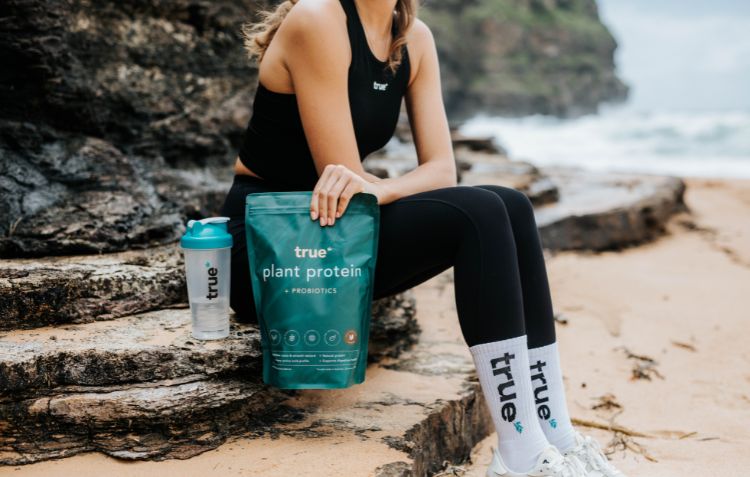A vegan diet involves excluding all animal products from one's diet. Its popularity has been steadily increasing since 2012, with vegans representing 12.1% of the Australian population in 2019. The increase is mainly due to animal welfare related motives as well as personal well-being and environment related reasons. Cutting out certain foods from your diet can sometimes make it difficult to ensure adequate consumption of essential nutrients, including protein.
Protein is a fundamental nutrient that the body uses to create hormones and enzymes and build and repair cells, muscles and bones. It can also promote proper growth and development throughout our life stages, muscle growth, maintenance and recovery. Proteins are made up of amino acids. Our body synthesises some amino acids but not others, meaning we must get them from our diet. These amino acids are known as essential.
When we think of high protein foods, we think of fish, beef, chicken and eggs. However, a vegan diet prevents you from eating any of these foods, making it difficult for them to reach their daily protein target. However, there are many vegan friendly foods that are also high in protein available, and we are going to explore 10 of them.
1. Tofu - 100g serving = 8g protein
Tofu, made of soy beans, is formed through a process similar to cheesemaking. It originated in China and offers 8 grams of protein in a 100-gram serving, offering 8 essential amino acids. Tofu is a versatile food that is mostly tasteless, however, if seasoned and cooked correctly can make a delicious addition to any stir fry, salad or bowl.
2. Lentils - 1 cup = 17g protein
Lentils are a seed from the legume family that is often overlooked as their nutritional value is often unknown. In a 1 cup serving, there are 17 grams of protein, making it a great meat alternative. Lentils can be boiled or baked and are an excellent protein-packed addition to any soup or salad.
3. Chickpeas - 100g serving = 19g protein
Chickpeas also come from the legume family; they have a nutty taste and a grainy texture. They are a great source of carbohydrates and protein, containing 19 grams of protein in a 100g serving. They are found commonly in grocery stores, either canned or dried. Chickpeas can be easily added to soups and salads and can also be eaten on their own as a snack.
4. Almonds - ¼ cup = 7g protein
Almonds are a type of seed that is commonly mistaken for nuts. They're packed with antioxidants and protein, with a quarter of a cup serving containing 7g of protein. Almonds are a tasty snack and can also be a great protein addition to salads.
5. Quinoa - 1 cup = 8g protein
Quinoa is a type of seed that is prepared and eaten as if it is a grain. It is exceptionally nutritious and contains all 9 essential amino acids and 8 grams of protein in a 1 cup serving. Quinoa is highly versatile and can be added to any salad or make an excellent pasta or rice substitute.
6. Chia seeds 2 tablespoons = 4g protein
Chia seeds are an unprocessed, whole-grain food that the body can efficiently process. They have a mild flavour which makes them a simple and easy addition to meals. They are beneficial not only for their nutritional value but also to keep you fuller for longer. Chia seeds are excellent in yogurt, smoothies, rice dishes or even just water.
7. Edamame - 1 cup = 18g protein
Edamame, like tofu, is a version of soybean. It is a complete, immature form that is green in colour. Edamame is 12% protein and contains all the essential amino acids. They are often served in sushi bars and make a great addition to soups, salads or on their own as a snack.
8. Wild Rice - 100g serving = 15g protein
Wild rice is a whole grain traditionally used by Native Americans. It is different to regular rice, however, it is referred to as rice as it looks and cooks the same as other rice. It has a more robust flavour and is often more expensive; but can be a worthy investment as its protein content is greater. Wild rice can be used as a substitute for pasta, potato or white rice and is excellent for salads, soups or casseroles.
9. Nutritional Yeast - 2 tablespoons = 8g protein
Nutritional yeast has gained popularity as a vegan staple. It is a cheesy tasting type of yeast that is an excellent source of vitamins and minerals. We can easily add it to meals or snacks for an extra punch of protein and flavour.
10. True Protein Plant Protein - 30g serving = 20g protein
True Protein's Plant Protein is a a triple blend of Australian yellow pea, Australian faba bean and organic pumpkin seed proteins. There is 20g of protein in just one serving, making it a great way to achieve your daily protein target. This protein powder comes in 3 flavours and can be added to baking, smoothies or protein shakes.
Key Takeaways
It can be challenging for vegans to ensure they are consuming enough protein, especially if looking to achieve weight-related goals. However, we have listed here a variety of delicious ways that you can incorporate additional protein into your diet. Try adding at least one of these foods into your each of your meals throughout the day and supplement with protein powder!
References
-
Life on the Pass. (2020). The Rise of Veganism in Australia. [online] Available at: https://www.lifeonthepass.com/featured/the-rise-of-veganism-in-australia/.doi:10.3402/mehd.v26.26191.
-
Janssen, M., Busch, C., Rödiger, M. and Hamm, U. (2016). Motives of consumers following a vegan diet and their attitudes towards animal agriculture. Appetite, 105, pp.643–651.doi:10.3402/mehd.v26.26191.
-
www.medicalnewstoday.com. (n.d.). 15 best plant-based protein foods. [online] Available at: https://www.medicalnewstoday.com/articles/321474#protein-supplements.doi:10.3402/mehd.v26.26191.
-
Healthline. (2016). The 17 Best Protein Sources For Vegans and Vegetarians. [online] Available at: https://www.healthline.com/nutrition/protein-for-vegans-vegetarians#TOC_TITLE_HDR_14 [Accessed 5 Aug. 2021].doi:10.3402/mehd.v26.26191.
-
Lewin, J. (2019). The health benefits of tofu. [online] BBC Good Food. Available at: https://www.bbcgoodfood.com/howto/guide/ingredient-focus-tofu.doi:10.3402/mehd.v26.26191.



